May 23, 2018
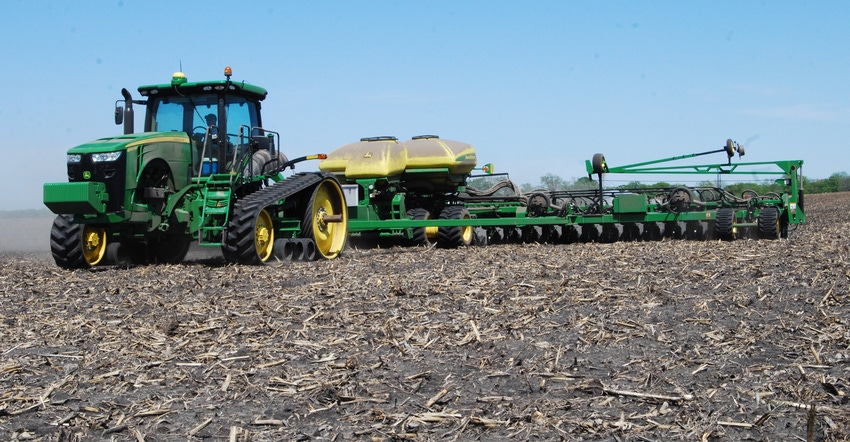
An Iowa State University survey shows cash rental rates for farmland in Iowa increased by 1.4% in 2018, after four years of continuous decline from the historical peak at $270 per acre in 2013.
The average cash rent in 2018 is still higher than the average rate in 2011, and only 17.8% lower than in 2013 (see Figure 1). In comparison, corn and soybean prices received by farmers in Iowa declined by 52% and 37%, respectively, since mid-2013.
Iowans supplied 1,596 responses to the survey about typical cash rental rates in their counties for land producing corn and soybeans, hay, oats, and pasture. Of these, 47% came from farmers, 29% from landowners, 13% from professional farm managers and real estate agents, 9% from ag lenders, and 2% from other professions. Respondents indicated being familiar with a total of 1.8 million cash-rented acres across the state.
Detailed results by county and crop are available in AgDM File C2-10, “Cash Rental Rates for Iowa 2018 Survey” on the Ag Decision Maker website. There was considerable variability across counties in year-to-year changes, as is typical of survey data, but 59 counties experienced increases in average rents for corn and soybeans. The report also shows typical rents for alfalfa, grass hay, oats, pasture, cornstalk grazing and hunting rights in each county and district.
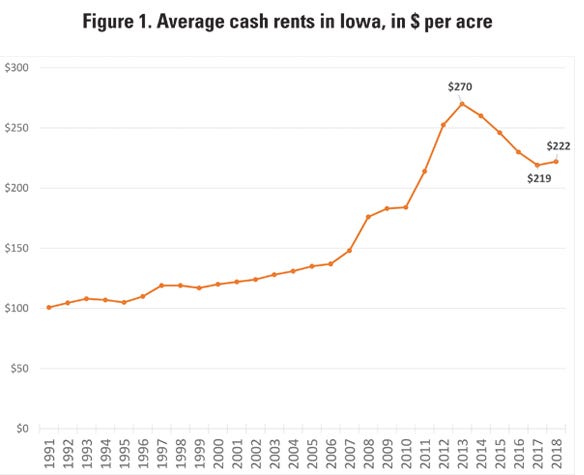
Survey shows increase in most districts
Statewide, reported rental rates for land planted to corn and soybeans were up from $219 per acre last year to $222 in 2018, or 1.4%. This percent increase is equivalent to about half the increase in Iowa farmland values between March 2017 and March 2018 reported in surveys conducted by the Iowa Realtors Land Institute and summarized in AgDM File C2-75, Farmland Value Survey (Realtors Land Institute).
But the 17.8% accumulated decline in rental rates since 2013 is in line with the cumulative 15.9% decline in land values reported in the Iowa Land Value Survey published by the ISU Center for Agriculture and Rural Development (AgDM File C2-70, “Farmland Value Survey”).
Different regions experienced different changes in cash rents: from a 3.9% increase in Crop Reporting District (CRD) 5 to a 3.3% drop in CRD 9 (figure 2). Northern and central Iowa (CRD 1-6) continue to have higher cash rents than southern Iowa (CRD 7-9).
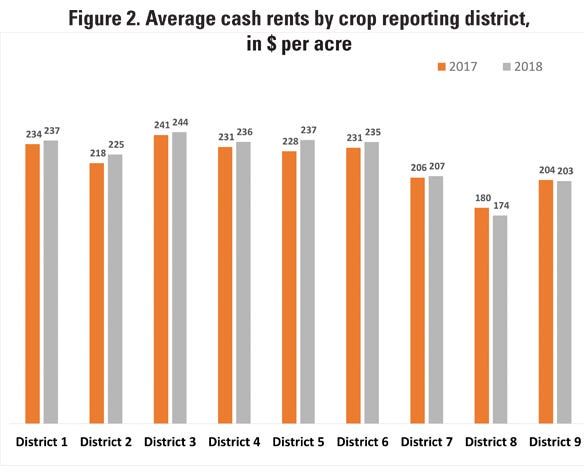
Rents for low quality land increased the most
Not all land qualities have seen their cash rents decline proportionately. High-quality land experienced a 0.8% increase, from $256 per acre in 2017 to $258 in 2018. Medium-quality land experienced a 0.9% increase, from $220 per acre in 2017 to $222 in 2018. Low-quality land experienced a 1.1% increase, from $183 per acre in 2017 to $185 in 2018.
Setting rents for next year
Survey information can serve as a reference point for negotiating an appropriate rental rate for next year. However, rents for individual farms should be based on productivity, ease of farming, fertility, drainage, local price patterns, longevity of the lease, and possible services performed by the tenant.
Two major factors with the potential to influence future cash rents are crop prices and land values. Corn and soybean prices received in Iowa peaked in August 2012 at $7.90 and $16.80 per bushel, respectively. In March 2018, corn and soybean prices were $3.40 and $9.60 per bushel, respectively, and have accumulated a 57% and 43% decline from their peak values (figure 3). Due to current and projected low crop prices, profit margins in corn and soybean production on cash rented acres are expected to remain very tight, and tenants will likely be using profits made in owned land to cover any negative profit margins on rented land.
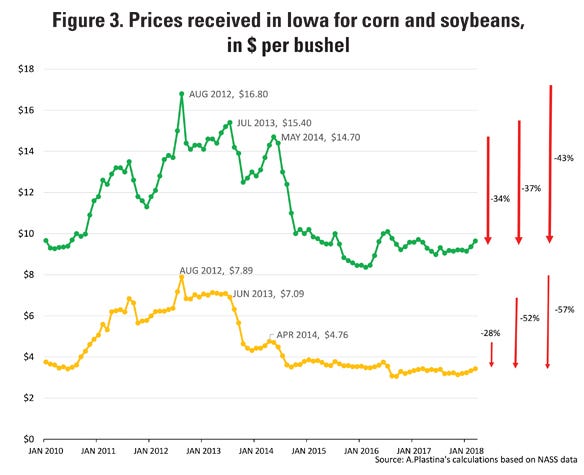
The second major factor affecting cash rents is the return on investment for landowners. Figure 4 shows the evolution of the ratio of average cash rents to average land values in Iowa. It suggests that the average return on investment for landowners who cash rent their land to operators has followed a declining trend since the early 1990s, and it has stabilized at around 3% after 2010. Note that this ratio does not measure net returns because ownership costs, such as real estate taxes, are not taken into account in its calculation.
However, it indicates that landowners whose goal is to obtain a reasonable rate of return on their real estate assets will likely be reticent to accept lower cash rents in the future unless land values continue to decline. Furthermore, in a scenario of increasing interest rates, the opportunity cost for landowners will increase and pressure will mount to increase the asking price for renting their land out.
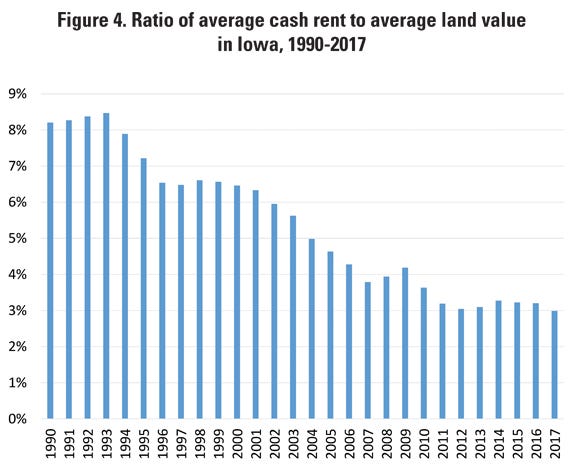
Other resources available for estimating a fair cash rent include the AgDM Information Files “Computing a Cropland Cash Rental Rate” (C2-20), “Computing a Pasture Rental Rate” (C2-23) and “Flexible Farm Lease Agreements” (C2-21). These fact sheets are on the Ag Decision Maker leasing page, and include decision tools (electronic spreadsheets) to help analyze individual leasing situations.
For questions regarding the cash rent survey, contact the authors. For leasing questions in general, contact a farm management field specialist in your area.
Plastina is an ISU Extension ag economist.
About the Author(s)
You May Also Like




